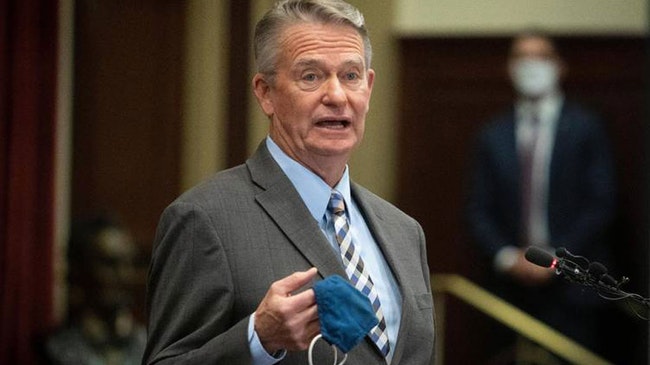
Idaho Gov. Brad Little on Oct. 26, 2020 discusses his decision to move Idaho back to a modified Stage 3 in its coronavirus recovery plan. On Friday, he rolled the state back another step, to a modified Stage 2. (Idaho Statesman – Katherine Jones)
Responding to Idaho’s worsening coronavirus crisis, Idaho Gov. Brad Little announced Friday that he is moving the state back to Stage 2 of its Idaho Rebounds reopening plan – with some modifications – but he resisted any stricter measures, such as a mask mandate.
The big impact of the move is on private and public gatherings, which will be limited to 10 people. Bars, nightclubs and some other businesses had to be closed in the original Stage 2, but that is not the case this time. They may remain open as long as they operate under coronavirus guidelines. At bars, for instance, there can be only table seating, just like in restaurants.
The gathering limits do not apply to religious or political events, according to the governor’s office. Little said his new executive order does not close any businesses.
With record numbers of cases this week and hospitalizations, Little announced Friday that he also will sign an order to mobilize members of the Idaho National Guard to help medical facilities deal with the virus. According to Little’s executive order, 100 members of the Guard will be mobilized for 30 days.
Hospitals have been struggling with staffing because health professionals are getting sick and can’t work, and hospital capacity also is a concern, Little said.
“This is the biggest challenge facing health care right now — the availability of trained healthy nurses and doctors to care for all patients, not just COVID-19 patients. This impacts all of us, whether we have COVID-19 or not,” Little said.
On Oct. 26, Little announced that Idaho would move backward into Stage 3 of the state’s Idaho Rebounds reopening plan. That move limited indoor gatherings to no more than 50 people as well as outdoor gatherings to 25% capacity. It was made after several months of Idaho remaining in Stage 4 of the plan, with the state repeatedly failing to meet the metric goals needed to move forward.
Dr. Christine Hahn, state epidemiologist for the Idaho Department of Health and Welfare, said the state has been missing the mark on a variety of metrics because of the latest surge: “It will be no surprise to any of you that things are not trending in the right direction.”
The governor once more emphasized the need for personal responsibility while refusing to enact a statewide mask mandate.
“Half of Idaho’s population is under a local ordinance requiring masks, but we are seeing noncompliance with those local orders. Or, people are wearing their masks in public but then take them off in social settings where the virus is more likely to spread,” Little said. “Law enforcement can cite individuals for violating local ordinances, but law enforcement cannot be everywhere all the time. That is why I maintain this comes down to personal responsibility. Please, wear a mask whenever you’re around another person who is not in your household so we can protect lives, preserve health care access for all of us, and continue our economic rebound.”
‘MY LUNGS WERE FAILING’
Among those who spoke during the governor’s press conference was a woman named Amelia Cortez, who contracted the coronavirus while pregnant and ended up in an ICU for weeks. She initially thought her symptoms were a part of her pregnancy before she went to a hospital unable to breathe.
“My body was shutting down and my lungs were failing,” Cortez said. “I did not expect to be fighting for my life for the next three weeks.”
Once she had recovered, Cortez struggled to walk and perform basic tasks. Her mother had to bathe her, clothe her and brush her teeth, she said. Cortez, occasionally pausing to catch her breath while talking, is still on oxygen. Cortez pleaded to younger people to take the coronavirus seriously.
“A lot of us young adults, we like to go out with our friends, go out to dinner,” Cortez said. “We tend to get careless. We as young adults need to activate and wake up, because COVID is real and is here to attack our lungs.”
Cortez’s respiratory therapist, Rachel Thain, said Amelia’s story is all too common. Thain said Idaho hospitals are at the point where calls are made daily from outlying facilities in Oregon, Washington and elsewhere in Idaho pleading with hospitals to admit patients.
“Not only are ICUs full, our floors are full,” Thain said. “We are at capacity, we don’t have staff to take care of our patients.”
At this point, not wearing a mask or doing so improperly is a sign of disrespect to health care workers, Thain said. Hospitals are doing everything they can to keep up the needed care, and the community needs to do its part.
“I’m begging you as a health care provider, help us take care of you,” Thain said.
COVID-19 IN IDAHO
Since the backward move on Oct. 26, Idaho’s coronavirus problems have only worsened.
Throughout this week Idaho broke its records for the most confirmed cases and overall cases in a single day, adding 1,250 confirmed cases and 1,618 total cases on Wednesday. Idaho’s positive testing rate hit an all-time high on Thursday, as 16.9% of tests were positive for the coronavirus.
Hospitalizations have grown to record levels, with 361 people in Idaho hospitalized because of COVID-19 as of Monday. The state had just 118 open ICU beds available for those in critical need as of Thursday.
On Thursday, St. Luke’s Health System announced that it would temporarily stop scheduling certain elective surgeries and procedures in response to the increasing coronavirus numbers. Elective surgeries that would require an overnight hospital stay were put on pause, as long as the surgery can be delayed 90 days or more.
The hospital system said a pause on pediatric admissions at St. Luke’s Magic Valley would also continue, with patients sent to other hospitals if they need admitted.
Saint Alphonsus Health System also announced that it had begun to “selectively limit surgical procedures that may be delayed without creating a risk to patients,” but only at its Idaho hospitals, according to spokesperson Mark Snider.
Little referenced the St. Luke’s move and the steps other medical centers are taking during his press conference to emphasize the toll of the virus.
“Alarmingly, our hospitals are telling us it is only a matter of weeks, at the current rate of spread, before they must start rationing care,” Little said.
CORONAVIRUS IN SCHOOLS
Members of the Boise School District Board of Trustees decided Thursday that the district will end in-person schooling at Thanksgiving break.
Students won’t return to in-person classes until at least Jan. 19., and the final day for in-person classes will be on Friday, Nov. 20. All athletics were suspended immediately through at least Jan. 15, including practices and workouts.
Districts around the state are trying to juggle hybrid schedules that allow for at least some in-person learning.
“We put millions of dollars toward the safe operation of schools. Schools are controlled environments and they remain safe places to work and learn, when protocols are followed. School buildings are not the place where virus transmission is occurring,” Little said.
“School closures threaten the biggest capacity issue facing our health care system — the availability of healthy workers. If a healthy nurse or doctor must stay home to facilitate online learning for their children, then they can’t care for the sick and help get us through this crisis. Our kids need to remain in school for in-person instruction as much as possible.”
Story published by mutual arrangement between the Idaho Statesman and the Enterprise.




